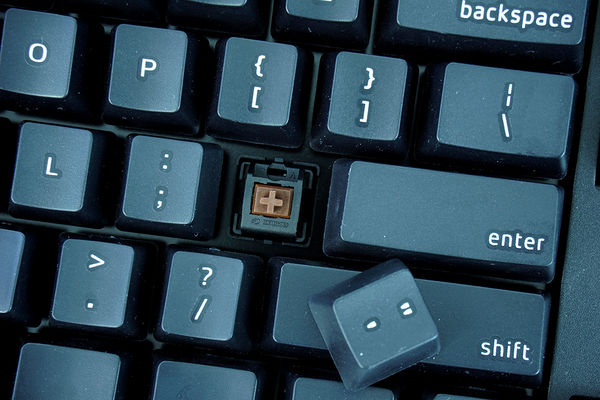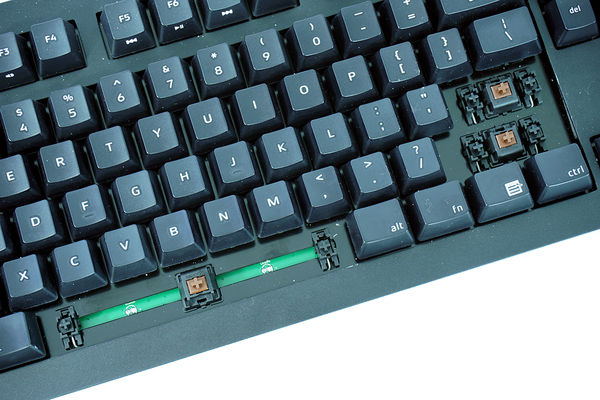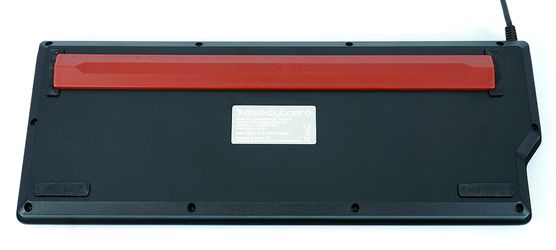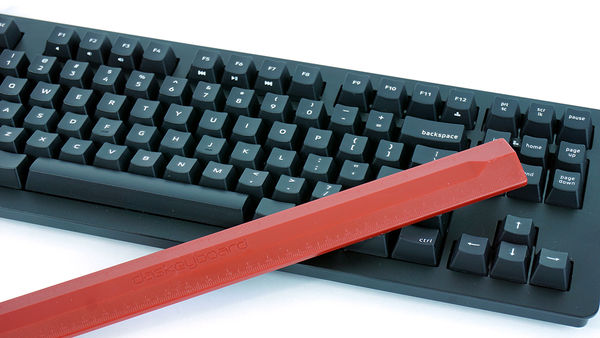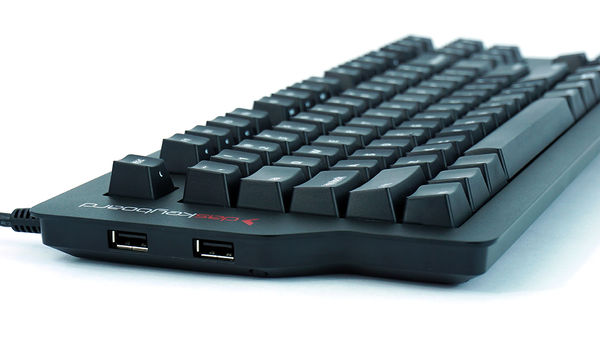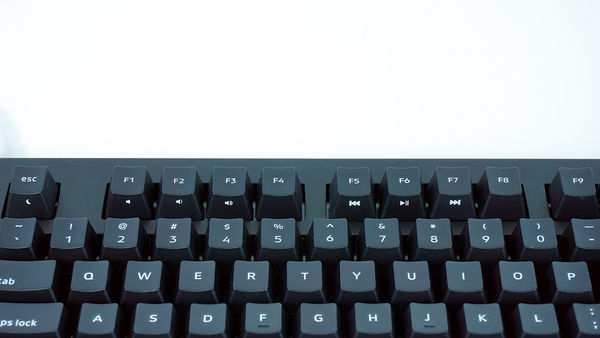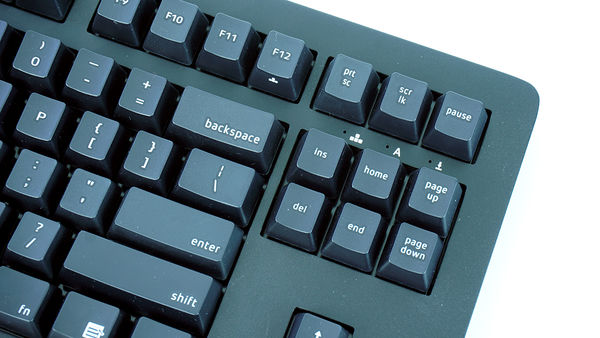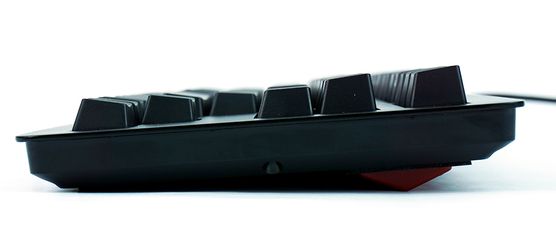Das Keyboard 4C Professional Review
We review the Das Keyboard 4C Professional, a straightforward tenkeyless keyboard with Greetech Brown switches.
Why you can trust Tom's Hardware
Product Tour
The tenkeyless, 87-key 4C Professional is, as you would expect, nice and compact. It’s a relatively hefty device though, and between its weight and four long rubber feet (about an inch and a half long each), the keyboard simply does not slide around or shift on a desk at all.
The whole thing feels incredibly sturdy, thanks in part to its anodized aluminum top plate. In order to create any flexion at all, you have to roll up your sleeves and put your back into it. The Greetech brown switches have gold-plated contacts, and they’re rated for 50 million keystrokes. There's also a model with blue switches for a clickier experience, if you'd prefer that.
You can clearly feel both switch points on the keys, and the kickback is quite strong. As a result, you also get a distinct feel for the shallow pre-travel. The 4C Professional claims an actuation force of 60g (max).
The space bar and the wider keys employ a Greetech brown switch in the middle that's flanked by two Cherry stabilizers.
Das Keyboard has taken to including a thin riser with the 4C series. It’s bright red to match some of the lettering, and it has magnets that firmly affix it to the bottom of the keyboard. It’s worth noting that with the riser attached, the keyboard is far more likely to slide around on your desk. Its hard plastic edge doesn’t exactly offer the same grip and friction as the rubber feet.
The keyboard is plug-and-play, so there’s no software to fiddle with. It sports a long (6.5-foot) cable with a single USB connector; the keyboard end is wired directly into the board, a decision Das Keyboard says it made because a removable USB connection is too unreliable over time.
The USB end of the cable connects the keyboard to your computer and also powers the 4C Professional’s two-port USB 2.0 hub. You can find the hub tucked underneath the left edge of the keyboard, out of sight. The two USB ports in the hub are spaced about 17mm apart, which should accommodate even bulky USB devices (charming-but-chunky USB flash drives, we’re looking at you).
Get Tom's Hardware's best news and in-depth reviews, straight to your inbox.
There are no dedicated media buttons on the 4C Professional, but the Esc and F keys pull double duty; with a press of the Fn key (located on the right side of the keyboard), the Esc key puts the system to sleep, and the F keys offer volume and playback controls.
The F12 key doubles as a Windows key disable control. We like that Das Keyboard conveniently places the Fn key on the right side of the board. This makes disabling the Windows key a quick, one-handed maneuver.
The keys are not back-lit. Although a lack of back-lighting no doubt appeals to a certain subset of prospective customers, it’s an omission that may be tough for others to swallow.
The keys are set inside of the chassis a bit, which makes cleaning slightly more difficult and will probably result in a generally dirtier keyboard. It’s basically designed to be a crumb-catcher, as opposed to, say, Corsair's K90. At least the aluminum top plate cleans up easily.
The concave key caps feature silk-screened characters with a clear UV hard coating, as opposed to prettier laser-etched keys. Some may balk at the look of printed key caps. Indeed, that telltale “sticker” look is painfully apparent. Das Keyboard said that the silk screen plus UV hard coat method is superior to laser etching, stating in a recent Tom’s Hardware AMA that the “durability of the print and the key surface is dramatically increased”.
That is perhaps true, although there’s an argument to be made that, well, who cares? Is it better to have nicer-looking key caps that fade over time, or less attractive ones that last longer?
The 4C Professional is the opposite of flashy, on purpose. Being tenkeyless, it’s nice and compact. And its simple, black austere look is attractive. The lack of extra dedicated media buttons further contributes to the clean look.
At this point, we would discuss software and accessories. In the case of the 4C Professional, though, there’s no software at all. And the only accessory is the riser mentioned above.
Seth Colaner previously served as News Director at Tom's Hardware. He covered technology news, focusing on keyboards, virtual reality, and wearables.
-
amk-aka-Phantom Close to $150 and it's not using Cherry switches *and* the markings are not laser-etched? Non-removable USB cable - do they even understand why people opt for TKL keyboards instead of full-sized ones? (Hint: it's often portability, and you do NOT want a cable sticking out while transporting the thing) And finally, no backlight. Why does everyone laud Das Keyboard so much? This product outright loses to CM QuickFire Rapid-i or Razer BlackWidow Chroma Tournament Edition. (Yes, I'm aware DK offers other models too, but if they can't get something as simple as a TKL right... then again, surprisingly, not many manufacturers can)Reply -
iam2thecrowe So long as when i press "a" on my keyboard, an "a" appears on the screen, to me that's a good keyboard....Reply -
Douglas_2 ReplySo long as when i press "a" on my keyboard, an "a" appears on the screen, to me that's a good keyboard....
I think you're on the wrong website. -
alidan ReplyClose to $150 and it's not using Cherry switches *and* the markings are not laser-etched? Non-removable USB cable - do they even understand why people opt for TKL keyboards instead of full-sized ones? (Hint: it's often portability, and you do NOT want a cable sticking out while transporting the thing) And finally, no backlight. Why does everyone laud Das Keyboard so much? This product outright loses to CM QuickFire Rapid-i or Razer BlackWidow Chroma Tournament Edition. (Yes, I'm aware DK offers other models too, but if they can't get something as simple as a TKL right... then again, surprisingly, not many manufacturers can)
razor black widow, if you take the keycaps off you void the warranty, as for the cm, i cant tell if its plate mounted keys or not.
as for backlight, i hate it.
as for das in general, i have an older version of their pro full keyboard, and i believe that the caps are laser etched, it was 120$, honestly can't complain about it outside nitpicks and a crappy space bar i had to mod to get to work correctly.
sadly i got the keyboard right as my hands were going to hell so yea, it gets limited use apposed to what i was planning to use it for. -
avatar_raq I got the much superior Corsair K70 RGB for $150 off amazon and it has cherry MX switches with highly customizable back lights that can be turned off altogether.Reply -
JQB45 I also prefer no back light on my keyboards. The keyboard is for professionals as implied by its name. Most professionals can type in the dark without needing to look at the keyboard. I've found the times when I do need to look at my keyboard in the dark that the light given off by my monitor is sufficient illumination.Reply
With that said I don't think this keyboard is worth its price. For a similar to slightly higher price you can customize the keyboards made by WASD Keyboards.
http://www.wasdkeyboards.com/index.php/ -
smithbs I used to have a das keyboard professional, and ruined it by touching it and giving it a static shock. Unfortunately, DAS keyboard doesn't sell just the logic board, and they don't offer to repair the keyboard. I bought this to replace it, and didn't care for the greetech switches.Reply
They had a similar weight to the cherry switches, maybe slightly heavier, but were really scratchy. I ended up returning it and got a WASD keyboard. -
scolaner Reply17448684 said:Close to $150 and it's not using Cherry switches *and* the markings are not laser-etched? Non-removable USB cable - do they even understand why people opt for TKL keyboards instead of full-sized ones? (Hint: it's often portability, and you do NOT want a cable sticking out while transporting the thing) And finally, no backlight. Why does everyone laud Das Keyboard so much? This product outright loses to CM QuickFire Rapid-i or Razer BlackWidow Chroma Tournament Edition. (Yes, I'm aware DK offers other models too, but if they can't get something as simple as a TKL right... then again, surprisingly, not many manufacturers can)
Good point about the non-removable USB cable. But I would disagree with your assertion that people like TKL ONLY for transport. Lots of people just like the compactness of them and don't need the numpad.
Also, interesting thing about the keycaps...I think these on the DK 4C are not especially attractive, but they swear by the durability. Laser etching looks beautiful but can wear over time. So it's kind of a judgment call.
Why are you concerned about the lack of Cherry switches?
-
amk-aka-Phantom ReplyGood point about the non-removable USB cable. But I would disagree with your assertion that people like TKL ONLY for transport. Lots of people just like the compactness of them and don't need the numpad.
Also, interesting thing about the keycaps...I think these on the DK 4C are not especially attractive, but they swear by the durability. Laser etching looks beautiful but can wear over time. So it's kind of a judgment call.
Why are you concerned about the lack of Cherry switches?
Well, I did say "often"... I also don't transport my keyboard frequently and indeed prefer TKL keyboards primarily for the space on the right they free up. But when you're paying $100-150 for a keyboard, a detachable cable is a very minor thing to factor into its cost and can end up saving you a lot of pain even if you don't travel with it. I'm sure a lot of people had their pets or children ruin their peripherals' cables, for example...
As for the Cherry switches, it's quite simple. We can all agree on their overall quality, and in my opinion, when you've got something that works well and can be trusted, any change to another manufacturer is a risk that's passed onto the consumer.
What's even more important is that most mechanical keyboard enthusiasts have tried at least several keyboards before deciding on one, and most of these keyboards were likely equipped with Cherry switches. Try one Cherry MX Brown, you've pretty much tried them all - you know what to expect from another keyboard with them. Greentech? I have no idea. See smithbs's reply above - "similar weight to the cherry switches, maybe slightly heavier, but were really scratchy". That's a gamble I personally really wouldn't want to take. Also why I'm still not fully convinced about Razer's TKL (not much choice after CM admitted they can't give me a QF Rapid-i where LEDs don't die after a few weeks) - they're using Kailh switches and even though they're "close" to Cherry's Brown and Blue, I'm still cautious. So naturally, I'm disappointed to see a potential alternative crossed off my list.
